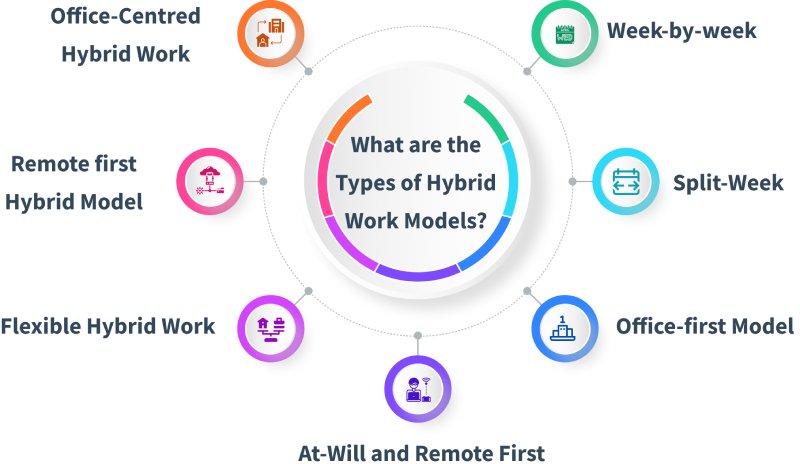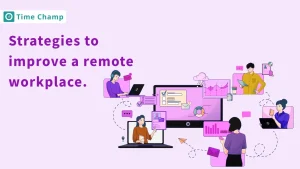Hybrid work has gained pace to become the new, highly sought mode of working; it introduces the balance between flexibility and traditional office settings. What is hybrid work, and how can it reap mutual benefits for employees and businesses? Read on to find insights into this hybrid work model and how it can help to modernize your workforce.
What is Hybrid Work?
Hybrid work is a flexible arrangement where employees divide their work between working at home and going to the office. This approach combines the benefits of in-person collaboration with the convenience of remote work, offering employees more control over where they work. Hybrid work aims to enhance work-life balance and improve productivity, and flexibility while maintaining opportunities for team connection and collaboration.
What are the Types of Hybrid Work Models?
Hybrid work models can come in various forms to suit different business needs. This section will provide the types of models and how they are designed to cater to other organizational structures and employee preferences.

1. Office-Centered Hybrid Work
In this hybrid model, employees work mostly in the office but can spend a couple of days working from home. It usually operates on the in-office day according to team requirements or schedules. This hybrid work model provides team bonding and collaboration while also providing flexibility for personal commitments. It is best for those companies that depend more on teamwork and in-person collaboration, ensuring that essential meetings and collaborative tasks are done face-to-face.
2. Remote first Hybrid Model
A remote-first hybrid model favors remote work but provides a chance for employees to come into the office if needed. It can attract great talent because it can be drawn from different geographical locations and work styles. The model is more composed of asynchronous communication and results achievements rather than strict office attendance. This model thrives in a world where tech-driven industries prioritize innovation and flexibility over actual physical presence.
3. Flexible Hybrid Work
Flexible hybrid work allows employees to work from anywhere and at any time, whether it is at home, the office, or other locations. This employee autonomy with a focus on adaptability has its basis in individual preferences and lifestyle. Companies adopting this model ensure adequate resources and technology for the individual to perform from remote sites and promote a results-oriented approach. This flexibility can therefore improve employees’ satisfaction levels and productivity since employees can tailor their hybrid work environment to suit their needs.
4. At-Will and Remote First
It lets employees determine which days to work from home and which days to come to the office with complete freedom of choice without a fixed schedule. This encourages voluntary attendance in offices and interaction with team members along with face-to-face meetings. It best fits into startup environments or any creative industry, which easily blends with a hybrid work culture.
5. Office-first Model
The office-first is not a pure and classic hybrid model, but it does take on hybrid tendencies. Employees are based in the office for a larger portion of their work. This model suits industries requiring significant in-person collaboration and reinforces a strong organizational presence through regular face-to-face interactions.
6. Split-Week
The split-week model allows the splitting of the workweek into in-office days and remote workdays. Workers can report to the office during specific days of the workweek, and then they work remotely on other days. The balance between collaboration on the in-office days and flexible work arrangements could be achieved this way, as they could focus deeply on home while getting their team tasks done together.
7. Week-by-week
In a week-by-week hybrid model, employees alternate between remote work and in-office work over weeks. This means the hybrid work schedule has a rhythm where employees interact with each other and collaborate throughout the in-office weeks, whereas at the same time, it saves on commutes and enables quality dedicated time to focus on projects without interruptions improving the overall hybrid work arrangement.
What Factors are Supporting Hybrid Work?
Several key drivers have influenced this shift to hybrid work models, both from the needs of organizations and the expectations of employees. These drivers are reshaping how companies operate and how employees approach their work-life balance. Here are the primary factors pushing the rise of hybrid work:

1. Employee Demand for Flexibility
Employees want to have the option to determine where and when they work. The long, traditional 9-to-5 office culture is hence fading out of the current picture. Hybrid work allows employees to balance their professional and personal responsibilities, making it a highly attractive option for today’s workforce.
2. Technological Innovation
Hybrid work environments have been made feasible through recent developments in technology. Cloud-based systems, video conferencing tools, and digital collaboration platforms enable teams to stay connected and productively continue the work from remote locations. Due to these technologies, it has become easy for companies to embrace the hybrid work model without sacrificing performance.
3. Cost Benefits
Hybrid work for both employers and employees offers exceptional potential for cost savings. Companies can reduce office space and overheads, while employees save on commuting and daily expenses. This financial efficiency becomes the prime reason for firms to adopt hybrid work models.
Modern workspace culture moves away from the rigid structures known in the past. It encourages autonomy, flexibility, and trust. The hybrid working model reflects this by creating a more fluid, adaptive, and inclusive work culture that pays respect to individual work preferences. Hybrid work, therefore, is appealing to both employees and organizations since shifts highly influence it in culture.
Benefits of Hybrid Work Environment
As said by the CEO of Google Sundar Pichai, “Remote work is here to stay. The future of work is a hybrid model.” Hybrid work forms the core pillar of the modern workforce. Let’s explore the key benefits of a hybrid work environment.

Tailored Work-Life Integration
One of the benefits of a hybrid work arrangement is employees’ ability to align work and personal life. Flexible schedules and locations allow workers to organize the day “to space out” professional tasks with personal commitments without sacrificing either aspect. This would likely maximize the satisfaction derived and reduce burnout. For example, a parent working from home can take a short break to pick up their child from school, and then return to work without the stress of a commute.
Optimizes Work Performance
The hybrid working model promotes productivity through its availability between in-office collaboration and focused remote work. Employees may reserve days for teamwork and meetings and use the rest for deep, uninterrupted work. That flexibility boosts individual performance and helps maximize output throughout the team. For example, the software development team may hold brainstorming sessions in the office on Monday and spend the rest of the week coding from home.
Expanding Recruitment Reach
This hybrid work culture will help businesses attract talent from a wider geographic area, thus allowing businesses to seek the best expertise globally. This becomes a breeding ground for diversity and innovation, as teams draw from diverse perspectives and expertise. By eliminating the need for local hiring, companies can more easily fill out any gaps in specialized roles and enhance overall team performance.
Improves Employee Well-Being
A hybrid work environment positively impacts employee well-being, as this model has more control over the workspace and schedule. There are fewer commutes, and the ability to work from a comfortable environment reduces stress while adding more to having better mental health and greater job satisfaction. This balance of work and personal life can lead to higher engagement, productivity, and long-term retention of employees.
Challenges in Managing a Hybrid Workforce
It is a lesser-known fact that 74% of employees think that a hybrid work model will become the norm in the offices in the coming years. This trend brings unique challenges for management. In this section, we’ll focus on the challenges that organizations face in managing a hybrid workforce.
Bridging Communication Divides
With the shift to a hybrid workforce, effective communication is a key challenge. Those small but powerful spontaneous office conversations can be lost in a remote team, leading to misunderstandings and more isolated employees. Organizations need to develop communication protocols that foster regular check-ins, digital collaboration tools, and a transparent strategy on all channels so everyone feels part of the hybrid work environment.
Navigating Security Risks
Cybersecurity becomes more complex in a hybrid setup because employees use various devices and networks. The protection of such sensitive information requires strong security measures like VPNs, encryption, and constant cybersecurity training. Organizations must ensure that employees working both on-site and off-site have some guidelines on security and best practices regarding the protection of data for a safe hybrid workspace.
Evaluating Performance Fairly
Measuring productivity in a hybrid work environment may not always be easy. Remote workers are invisibly cast over themselves, and traditional hours-worked metrics can’t reflect their contribution level. Managers have to establish appropriate results-oriented performance goals. Proper utilization of performance tracking tools promotes equable treatment of employees regardless of whether they are working remotely or in the office.
Engaging a Diverse Workforce
Strategic approaches need to be developed to keep employees engaged across different locations. The culture and goals of the company can leave a disengaged feeling in remote employees. Regular feedback sessions, virtual recognition, and the involvement of remote workers in key initiatives help make these connections stronger. A connected hybrid workforce raises motivation and drives overall engagement.
Best Practices for Effective Hybrid Work Implementation
The way a company is going to use the hybrid model is the result of thoughtful strategies and practices. In this section, we’ll outline best practices that will enable organizations to move through the change productively and enhance overall performance.
Clearly Define Hybrid Work Policies
-
Establish a clear hybrid work policy that outlines clear expectations, schedules, communication norms, and technological requirements.
-
Define which employees are permitted to work in hybrid spaces, how frequently employees need to be in the office, and what is considered an acceptable practice of remote work.
Train Managers for Hybrid Leadership
-
Assist managers in developing the necessary leadership abilities to oversee remote teams, including effective communication, handling conflict, and remote management.
-
Additionally, managers are asked to take a more proactive approach to the growth and involvement of every team member.
Reassess and Adapt Regularly
-
Feedback can be solicited from employees about what is going right and what is not.
-
Be ready to make changes in policy, tools, and practices per change or modification in the needs of the organization and employees.
Establish Hybrid-Specific Professional Development Programs
-
Skills for a productive hybrid work model, whether in virtual collaboration, remote leadership, or digital communication, should be included in the learning and development programs.
-
This will open opportunities for remote and hybrid workers to advance professionally while eliminating the “proximity bias” from which on-site employees benefit.
-
Hybrid mentorship and training enable all the employees on the team to grow and develop.
How Time Champ Supports Hybrid Work Models
Hybrid work models are the future of doing business, and in such a line, Time Champ offers the gateway for preserving efficiency and productivity. Advanced time-tracking features allow the employees to log their work hours as well as project progress from anywhere, thus making remote and in-office teams stay in touch and aligned.
Time Champ offers customized dashboards that provide managers with a transparent view of the running tasks, deadlines, and overall workload, making the management of hybrid teams easier. It eliminates the constant need for check-in as it offers real-time insights and more than that, it builds trust rather than fostering micromanagement.
Further, Time Champ centralizes essential data such as employee work hours, task durations, project progress, and productivity metrics, streamlining communication between team members. Employees receive their productivity reports and can change their work habits accordingly, while managers track how the entire team has been performing overall and can make informed decisions.
The platform also simplifies scheduling by allowing teams to track flexible work arrangements. Whether employees are working from home or in the office, Time Champ makes it easy to coordinate and optimize workdays, ensuring everyone is productive, engaged, and focused in this hybrid work setting. Start your 7-day free trial today.
Conclusion
The hybrid work model is significant in creating an environment in which the organizational system can exhibit various work preferences that maximize the potential of employees. This kind of freedom encourages more creativity and better work-life balance for sustainable growth.
Boost your hybrid workforce efficiency with Time Champ!
Empower your team for success today with a 7-day free trial!
Signup for FreeBook DemoFrequently Asked Questions
Some of the essential tools are Slack, a platform that communicates, Asana for management, Zoom for video conferencing, and Google Drive, cloud storage. They enhance communication and ensure remote employees and in-office employees are connected.
The future of hybrid work looks promising, as more and more organizations start shifting toward flexible models. Enhanced technology will support this shift, focusing on the well-being and outcomes of employees rather than hours worked, to develop a more adaptable workforce.
Legal considerations include labor laws, safety regulations at the workplace, and issues of privacy of data. The latter involves adherence to locality laws and the development of clear expectations to avert discrimination cases and observe employee rights.
Effectiveness can be measured in companies through KPIs such as productivity, engagement, and retention. Feedback surveys that are frequently undertaken with performance appraisals will give the information while tracking the completed projects will determine the extent to which the hybrid model can meet the objectives of the organization.






